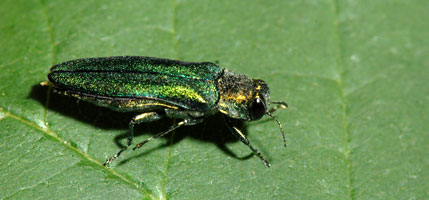Owner's guide to the fight against emerald ash border
This page has been created to help residents deal with the imminent arrival of the emerald ash borer in Dollard-des-Ormeaux. To keep the material presented on this web page current, links are provided to websites that are updated on a regular basis.

To counter the emerald ash borer threat, Dollard-des-Ormeaux residents are advised to:
- Identify ash trees on your property
- Understand how the emerald ash borer works
- Advise the City at the first sign of infestation
- Consider preventive biopesticide treatment
- Understand the appropriate courses of action for the felling and disposal of the ash tree and its wood
- Plan for the replanting of alternate species of tree(s) to replace the felled ash tree
1. Identifying/inventory ash trees on your property
Ash trees are plentiful and make up approximately 15% to 30% of Dollard-des-Ormeaux’s urban forest.
Ash trees can be identified by their leaf configuration and bark texture.
Ash leaves and branches grow opposite each other on the stem.
The bark of a mature ash tree has a coarse diamond-patterned texture.
For more information on identifying ash trees, consult the following sites:
If you are unsure whether you have an ash tree on your property, email at arbo@ddo.qc.ca or call Public Works (514-684-1034) and an inspector will visit you to help you identify the tree(s) in question.
2. Understanding how the emerald ash border works
The emerald ash borer, Agrilus planipennis, is an invasive insect species that was first found in North America in the Detroit area in June 2002. For further information:
In 2002, the emerald ash borer was discovered in the Detroit, Michigan area and has since spread to cover the majority of the Great Lakes region and the St. Lawrence valley corridor.
The threat
The emerald ash borer is able to attack and kill healthy ash trees, regardless of variety.
Ash trees of all sizes are susceptible to this threat. Larvae have been found in branches as small as 1.1 cm in diameter.
Emerald ash borer infestation is very difficult to detect early. When infested trees are found, it’s often one year or more after the attack has occurred. Additionally, there are several other factors affecting ash tree health that may disguise the presence of the emerald ash borer.
Estimates show the emerald ash borer has killed several hundred thousand ash trees in Essex County, Ontario, and 8 to 10 million ash trees in southeastern Michigan. Tree losses include landscape, rural and woodlot trees. If not effectively controlled, the emerald ash borer is expected to spread across the entire North American range of ash, causing widespread tree mortality.
Four signs of infestation
- Crown dieback: the first sign of emerald ash borer infestation is thinning or dieback of the outermost extremities of the crown of the ash tree due to the effect of the under-bark larvae choking off nutrient flow.
- New growth shoots around the trunk of the ash treeShoots (suckers) can be seen growing around the portion of the trunk lower than the larval infestation as the tree attempts to survive.
- Presence of D-shaped exit holes: as the young adult emerald ash borer emerges from under the ash tree’s bark, it creates a D-shaped hole in the bark approximately 4 mm (3/16″) wide.
- Woodpeckers: they are very good at finding larvae under the bark. Increased woodpecker feeding activity in your ash tree could point to infestation of the tree by the emerald ash borer.
The emerald ash borer’s affected area changes as the advancement of the pest progresses. View Canadian Food Inspection Agency (CFIA) updates on affected emerald ash borer areas.
3. Advising the city at the first sign of infestation
If you are having difficulty identifying ash trees on your property or believe you have an infested ash tree at your address, be it either a private or public ash tree, email at arbo@ddo.qc.ca or call Public Works (514-684-1034) at the first sign of infestation and we will dispatch an inspector to do a site visit.
Our service is relaying all infestation information for Dollard-des-Ormeaux to the regional and federal authorities (i.e. Canadian Food Inspection Agency).
4. Consider preventive biopesticide treatment
Generally speaking, if your tree shows no symptoms or only early symptoms of infestation, it can be treated to prevent and/or slow the effects of infestation.
Currently, the only effective preventive treatment for emerald ash borer infestation that is approved in Canada is the natural pesticide TreeAzin®, which is applied every two years for the duration of the infestation threat.
Application involves the injection of the product into the ash tree at several injection points around the base of the trunk by a trained technician.
Who is authorized to apply TreeAzin® in the Montreal area? There are dozens of certified TreeAzin® service providers in the Montreal area. Use the BioForest Technologies Inc. service provider search resource.
The cost of treatment is typically less than the cost of felling a mature tree.
5. Felling and disposing of ash trees and its wood
If treatment is not an option for your private ash tree because it is dying, we ask that you understand and undertake the appropriate courses of action for the elimination of the dying ash tree from your property.
Do not leave yourself open to injury, damages to your property or claims from third parties, as dead trees become a public danger. Email at arbo@ddo.qc.ca or call Public Works (514-684-1034) for further information on tree felling and disposing of ash trees and its wood.
If you have any questions or concerns on disposing of ash trees ans its wood, click on the following link: Fire wood
